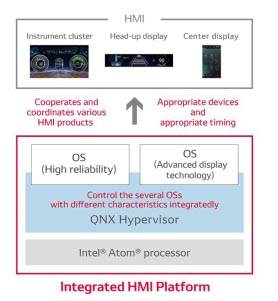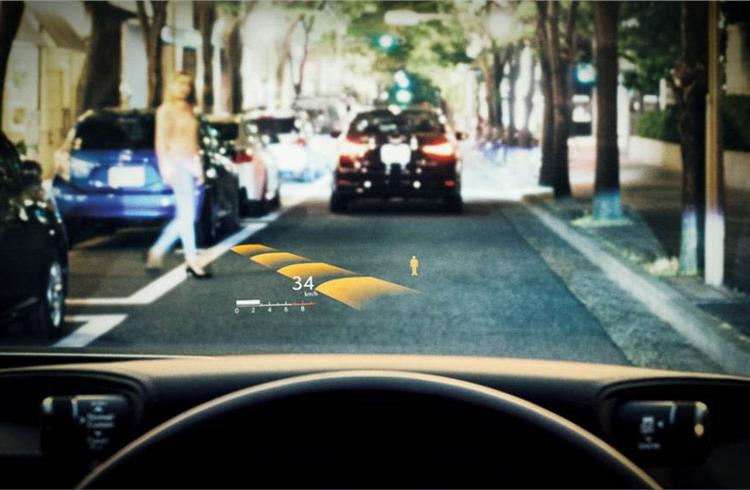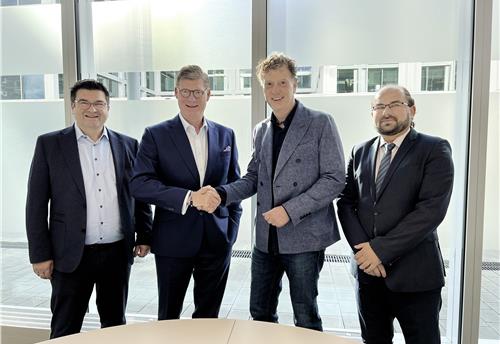Denso and BlackBerry develop world’s first integrated HMI Platform
Virtualisation technology enables integrated control of in-vehicle HMI systems. The integrated HMI platform will appear in successive car models scheduled for release after 2019.
Denso Corporation and BlackBerry have jointly developed what is claimed to be the world’s first integrated HMI (Human Machine Interface) platform. Intel Corp also collaborated in the development of this product.
The integrated HMI platform will enable a system which optimally cooperates and coordinates various HMI products such as display and sound inside the automobile cockpit at a low price. The integrated HMI platform will appear in successive car models scheduled for release after 2019.
With the improvement of automobile safety and convenience in recent years, the amount of data the vehicle transmits to the driver is increasing. Today, vehicles are equipped with multiple HMI systems, which require several device-specific operating systems (OSes) to work in unison. Because the OSes are independently controlled by multiple microcontrollers, it has not been possible to cooperate and coordinate them to display content and sound uniformly.

The integrated automotive HMI platform is believed to be the first of its kind and was developed by Denso and BlackBerry using BlackBerry’s QNX Hypervisor for virtualisation and the Intel Atom processor A3900 series. The hypervisor technology enables the independence of several OSes with different characteristics and controls the integration with one microcomputer.
This architecture allows various HMI products to cooperate allowing necessary information to be displayed to the appropriate devices with appropriate timing. For example, it will be possible to communicate a heads-up or a warning through easy-to-understand expressions on the display with the appropriate timing. Additionally, through cooperation between instrument cluster and navigation center displays, it is now possible to show animation with a sense of unity between the navigation screen in the meter screen. Furthermore, by updating the performance of one microcomputer the processing performance for screens of both devices is updated which contributes to improved increase in R&D productivity and cost reduction.
“Denso has developed various HMI products, such as instrument clusters, car navigation systems and head-up displays that contribute to the safety and the convenience of automobiles,” said Yukihiro Kato, senior executive director, Information & Safety Systems Business Group of Denso. “Leveraging the technology and know-how acquired through the development of these products, we have developed an information management HMI technology that will support the evolution of automobiles in collaboration with BlackBerry QNX and Intel.”
“While cluster, head unit, infotainment, and entertainment screens are all part of a new digital user experience in the car, they can’t be developed in isolation and need to work in tandem,” said John Wall, SVP and GM of BlackBerry QNX. “With help from Denso and Intel, BlackBerry QNX will provide a highly functional, virtual cockpit including a safety-certified digital instrument cluster that will be the new gold standard in the automotive industry. We look forward to working with them on many more projects in the future.”
As part of the integrated HMI, Intel has provided a unique and revolutionary graphics sharing technology, which it has optimized for the Intel Atom processor A3900 series, to the development efforts. The technology prioritises and operates 3D workloads important for safety and 3D workloads of less importance on the same processor.
Denso and BlackBerry are to display the new integrated HMI platform at the Consumer Electronics Show (CES) in Las Vegas to be held from January 9-12, 2018.
In October this year, Denso had revealed the world's largest head-up display. This HMI has a nearly 24-inch projection and is featured on the new 2018 Lexus LS.
RELATED ARTICLES
ZF to display next-gen e-axle for low-floor city buses at Busworld Turkiye 2024
The AxTrax 2 LF is available with a continuous output of up to 360 kW and a peak torque of up to 37,300 Nm.
Daimler Buses and BMZ Poland to develop next-gen NMC4 electric bus batteries
The new battery generation NMC4 – succeeding the current NMC3 technology – will combine high energy density, resulting i...
Netradyne expands UK operations via partnership with Intelex
The collaboration between Netradyne and Intelex marks a substantial leap forward in advancing road safety and fleet mana...





 By Autocar Pro News Desk
By Autocar Pro News Desk
 14 Dec 2017
14 Dec 2017
 4745 Views
4745 Views









